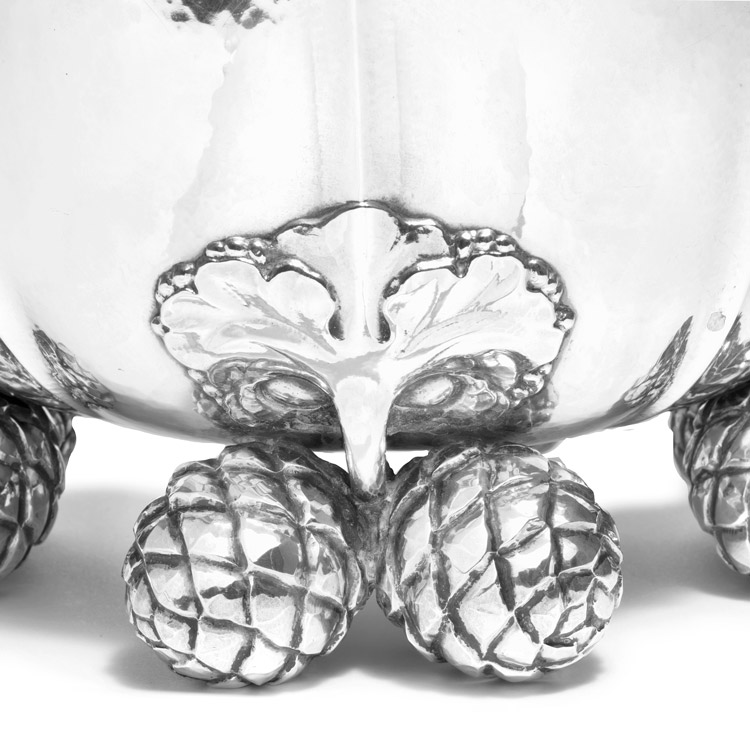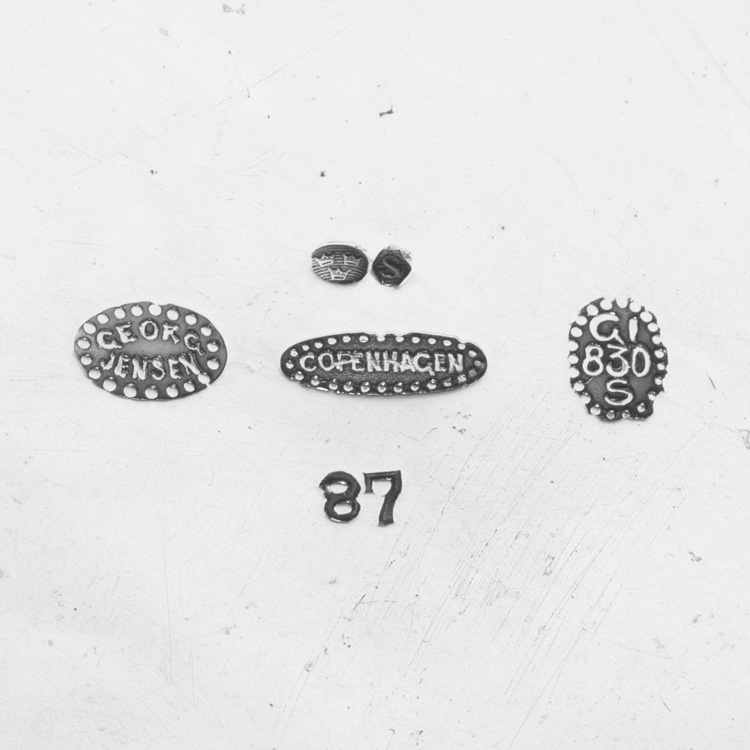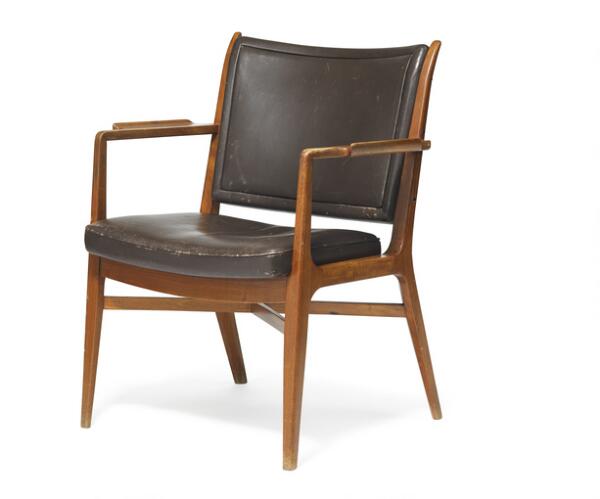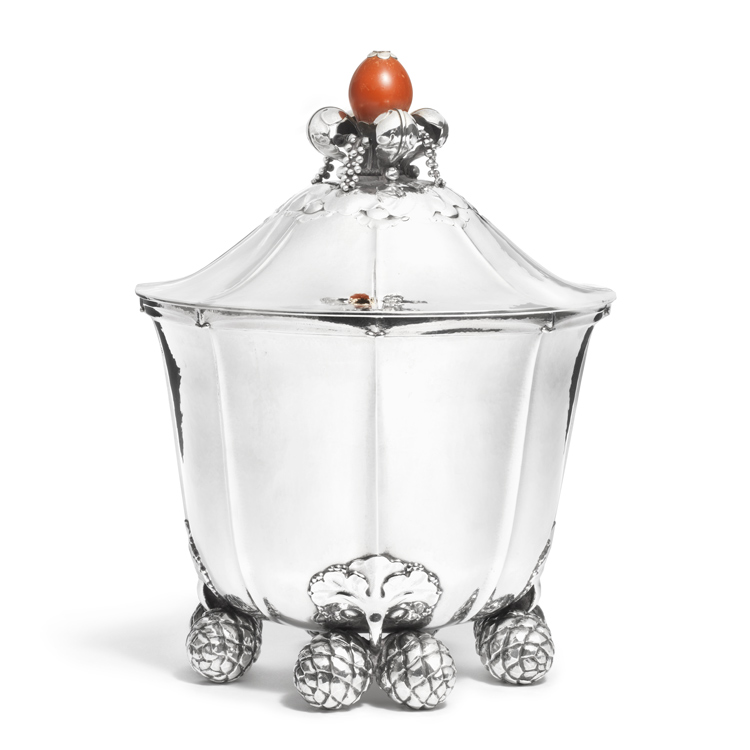Sjælden champagnekøler fra Georg Jensen
Georg Jensen har som virksomhed frembragt utallige bemærkelsesværdige genstande, siden den blev grundlagt i 1904. Lige fra sølvlysekronen skabt på bestilling til en svensk tændstikkonge i 1919 til spisepinde i ”Konge”- og ”Bernadotte”-mønster til det nye, asiatiske marked. Nu kommer en af de store sjældenheder – en pragtfuld champagnekøler af sølv tilhørende den svenske adelsslægt de Geer – på auktion.
Georg Jensen (f. 1866, d. 1935) og hans virksomhed er en vigtig del af dansk kulturarv og har for længst sikret sig en permanent plads i international designhistorie. I 1904 åbnede Georg Jensen sin sølvsmedje i Bredgade nr. 36 i København. Kendetegnet for sølvarbejderne har siden været høj kunstnerisk kvalitet, håndværksmæssig kunnen og en til alle tider nyskabende tilgang til kunstnerisk formgivning og funktionalitet. Georg Jensens smedje så dagens lys i en tid, hvor traditionelle værdier inden for kunsten var under forandring, industrialiseringen rasede, og det gamle håndværk var truet af maskinel masseproduktion.
”Det er et exceptionelt stykke kultur- og håndværkshistorie, der bliver materialiseret i et pragtstykke fra Georg Jensens Sølvsmedie, nemlig champagnekøleren i en helt særlig variant med lågknop af poleret rav, i modsætning til modellens ellers vanlige, bærformede sølvknop.”
Amalie HansenSpecialist i Moderne Kunsthåndværk, Moderne Sølv & Design hos Bruun Rasmussen
Champagnekøleren og de Geer-familien
Der er tale om en sjælden champagnekøler af sølv med låg og hamret overflade, opsat på fire, dobbelte koglefødder og ciseleret med bladværk. Låget er dekoreret med en knop af poleret rav omgivet af drueklaser. Selve modellen blev formgivet af Georg Jensen i 1915, og bestillingen af nærværende champagnekøler med ravknop blev oprindeligt foretaget af den svenske baron Louis de Geer af Leufsta (f. 1866, d. 1925) og er siden nedarvet i familien, i hvis eje den har været indtil nu. Udover det åbenlyse formål med køleren, der er ganske rummelig, kan nuværende ejer berette hvordan den i familien også blev anvendt som slikskål til familiefester.

|

|
Usædvanlige materialerI de tidlige år formgav Georg Jensen næsten alt selv ud fra idéen om, at det prismæssigt skulle være tilgængeligt for flere. Derfor benyttede han aldrig guld, men i stedet det hårde ”A380-sølv”, og hans smykker var ofte prydet med eksotiske og anderledes halvædelsten som rav, agat, koral, lapis lazuli, carneol og chrysophras. Stenene var ikke facetterede, men cabochonslebne og matte. Stilarten var skønvirke, hvis motiver som blomster, blade og bær blev hentet fra naturen. Og som den drevne forretningsmand han var, påtog han sig også gerne usædvanlige bestillingsopgaver for private. Den tekniske omhu og Georg Jensens store sans for detaljer ses også i champagnekøleren. |

|
”Når champagnekøleren tages i skue på nært hold, ser man for alvor det fine håndværksmæssige arbejde, der ligger bag; lige fra koglefødderne og de ciselerede blade til den detaljerigdom og finesse, der ses på indersiden af låget, og som karakteriserer korpussølv udgået fra Georg Jensens Sølvsmedie. For ikke alene skulle det udvendige udtryk på en ting af denne kaliber være i orden, men også de indvendige, funktionskrævende detaljer skulle være præsentable og stå i lighed med det, der var umiddelbart synligt for øjet. På denne sidste Traditionelle Auktion i Bredgade er her en enestående mulighed for at erhverve et stykke sølv af museal karakter med veldokumenteret proveniens og historie.”
Amalie HansenSpecialist i Moderne Kunsthåndværk, Moderne Sølv & Design hos Bruun Rasmussen
Fra kagebrækker til spisepinde
Et af Georg Jensens kendetegn var dengang som nu det upolerede design, der lader sølvets egne toner komme til sin ret. Hvor tidligere tiders sølvsmede helt fjernede alle spor af hammerslag, har Georg Jensen i modsætning til tidligere skabt tradition for med kontrollerede ciseleringer og hammerslag at tilføre små fordybninger i sølvet, så overfladen får et mere levende udtryk, der reflekterer lyset til fuldkommenhed. Det kræver til gengæld uhyggeligt mange arbejdstimer. Timer, der i datiden intet kostede, men i dag gør den ofte manuelle tilvirkning dyrere. Georg Jensen udviklede også en forskellighed i brugsgenstande, hvoraf flere i dag er gået ud af brug: ”Kagebrækker” er en af dem, ligesom den ”langskaftede spisekniv” ikke benyttes i så høj grad som tidligere. Til gengæld er former som ”Snack-skål” af ny dato.
De tidløse designere
Selvom Georg Jensen i begyndelsen var hovedkraften i smedjens formgivning, begyndte han efterhånden at samarbejde med andre formgivere som Thorvald Bindesbøll, Harald Nielsen, Sigvard Bernadotte, Henning Koppel og Vivianna Torun Bülow-Hübe, der i Georg Jensen regi har videreført traditionen for det gode håndværk.
Den sjældne champagnekøler kan ses på eftersyn fra 14. september og erhverves på Traditionel Auktion 21. september.

Har du spørgsmål, kontakt venligst
|
|
Amalie HansenAmalie HansenVurderingssagkyndig |
